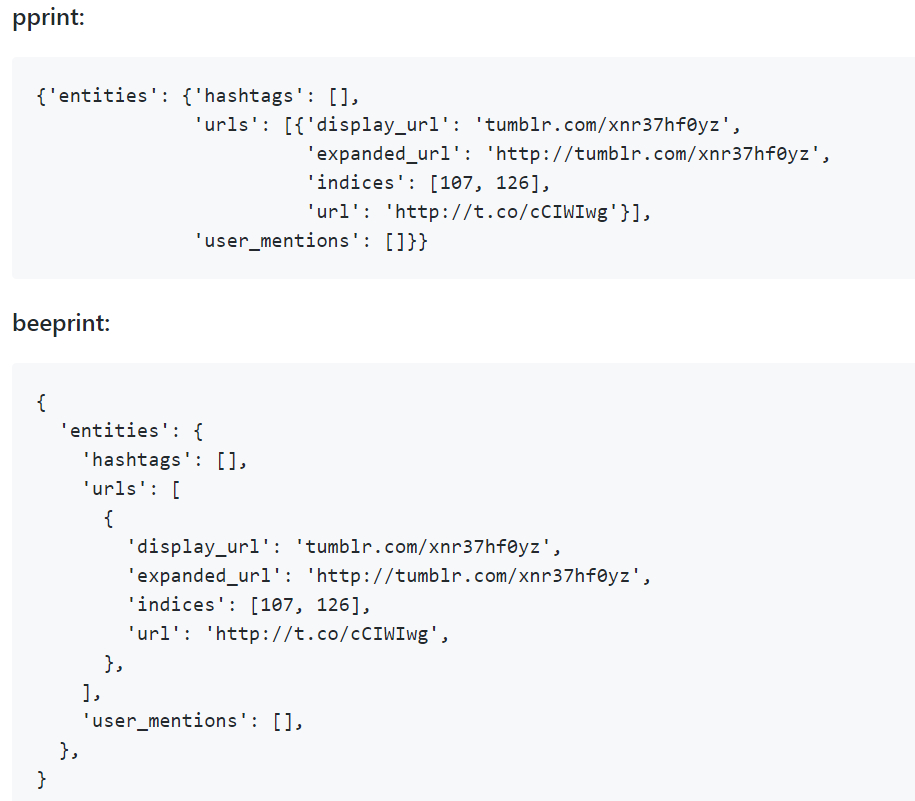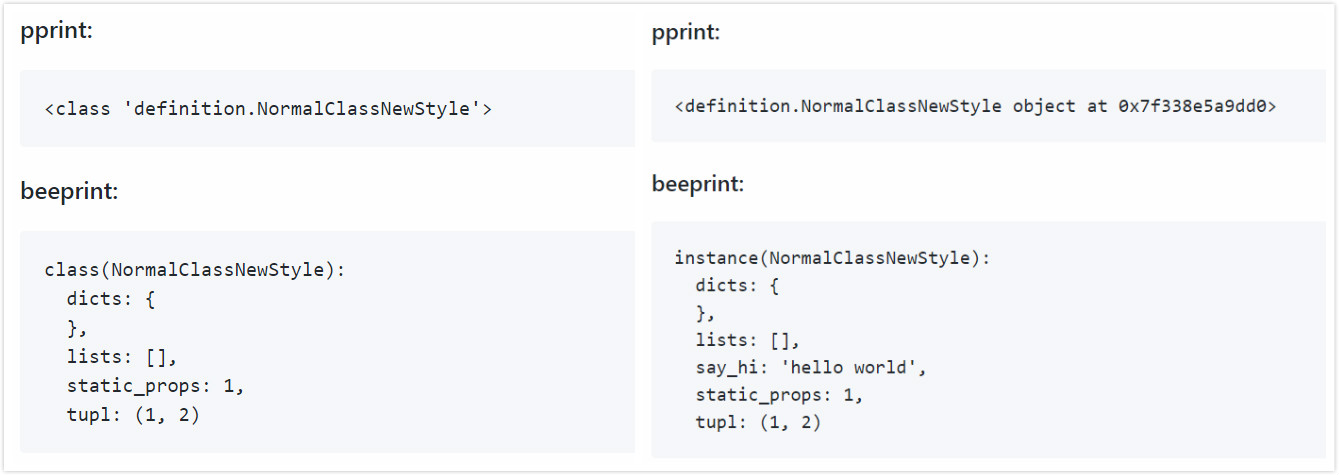
前不久,我写了一篇文章回顾 Python 中 print 的发展历史 ,提到了两条发展线索:
- 明线:早期的 print 语句带有 C 和 Shell 的影子,是个应用程序级的 statement,在最初十几年里,经历过 PEP-214 和 PEP-259 的改进;再到 2009 年的大版本 3.0,由语句改成了 print() 函数,还在 3.3 版本,做过一次功能增强,最终上升成为一等的内置函数。
- 暗线:介绍了 print 的竞争对手们,像传统的日志模块 logging、调试模块 pdb、主流 IDE 的调试功能,以及后起之秀 PySnooper,它们瞄准着 print 的位置,摩拳擦掌,虎视眈眈。
本文依然跟 print 相关,想介绍的是标准库中的 pprint 模块。
(未经授权,请勿转载。文章首发于:https://mp.weixin.qq.com/s/d1dQH1Fqaj_U3AXKYluhSw)
pprint 是“pretty printer”的简写,“pretty”的含义是“漂亮的、美观的”,还有表示“相当地”的程度语气,因此它的含义便是:(相当)美观的打印。
这是个相当简单却有用的模块,主要用于打印复杂的数据结构对象,例如多层嵌套的列表、元组和字典等。
先看看 print() 打印的一个例子:
mylist = ["Beautiful is better than ugly.", "Explicit is better than implicit.", "Simple is better than complex.", "Complex is better than complicated."]
print(mylist)
# 结果如下:
[\'Beautiful is better than ugly.\', \'Explicit is better than implicit.\', \'Simple is better than complex.\', \'Complex is better than complicated.\']
这是一个简单的例子,全部打印在一行里。
想象一下,如果对象中的元素是多层嵌套的内容(例如复杂的 Json 数据),或者有超多的元素(例如在列表中存了很多 URL 链接),再打印出来会是怎样?
那肯定是一团糟的,不好阅读。
使用 pprint 模块的 pprint() 替代 print(),可以解决如下痛点:
- 设置合适的行宽度,作适当的换行
- 设置打印的缩进、层级,进行格式化打印
- 判断对象中是否出现无限循环,并优化打印内容

1、简单使用
语法:pprint(object, stream=None, indent=1, width=80, depth=None, *,compact=False)
默认的行宽度参数为 80,当打印的字符(character)小于 80 时,pprint() 基本上等同于内置函数 print(),当字符超出时,它会作美化,进行格式化输出:
import pprint
# 打印上例的 mylist
pprint.pprint(mylist)
# 打印的元素是换行的(因为超出80字符):
[\'Beautiful is better than ugly.\',
\'Explicit is better than implicit.\',
\'Simple is better than complex.\',
\'Complex is better than complicated.\']
2、设置缩进为 4 个空格(默认为1)
pprint.pprint(mylist, indent=4)
[ \'Beautiful is better than ugly.\',
\'Explicit is better than implicit.\',
\'Simple is better than complex.\',
\'Complex is better than complicated.\']
3、设置打印的行宽
mydict = {\'students\': [{\'name\':\'Tom\', \'age\': 18},{\'name\':\'Jerry\', \'age\': 19}]}
pprint.pprint(mydict)
# 未超长:
{\'students\': [{\'age\': 18, \'name\': \'Tom\'}, {\'age\': 19, \'name\': \'Jerry\'}]}
pprint.pprint(mydict, width=20)
# 超长1:
{\'students\': [{\'age\': 18,
\'name\': \'Tom\'},
{\'age\': 19,
\'name\': \'Jerry\'}]}
pprint.pprint(mydict, width=70)
# 超长2:
{\'students\': [{\'age\': 18, \'name\': \'Tom\'},
{\'age\': 19, \'name\': \'Jerry\'}]}
4、设置打印的层级(默认全打印)
newlist = [1, [2, [3, [4, [5]]]]]
pprint.pprint(newlist, depth=3)
# 超出的层级会用...表示
[1, [2, [3, [...]]]]
5、优化循环结构的打印
当列表或其它数据结构中出现循环引用时,要完整打印出所有内容是不可能的。
所以 print 作了简化处理,就像上例一样,只打印外层的壳,而不打印内层循环的东西。
这种处理方式是简化了,但没有指出是谁导致了循环,还容易看漏。
pprint() 方法作了改进,遇到无限循环结构时,会表示成<Recursion on typename with id=number> 的格式。
还有个 saferepr() 方法,也是这样优化,而且返回的是个字符串:
newlist = [1, 2]
newlist.insert(0, newlist)
# 列表元素指向列表自身,造成循环引用
# 直接 print 的结果是:[[...], 1, 2]
pprint.pprint(newlist)
# [<Recursion on list with id=1741283656456>, 1, 2]
pprint.saferepr(newlist)
# \'[<Recursion on list with id=1741283656456>, 1, 2]\'
6、判断是否出现循环结构
有两个方法可以判断一个对象中是否出现无限循环:
pprint.isrecursive(newlist)
# True
pprint.isreadable(newlist)
# False
isreadable() 除了能像 isrecursive() 一样判断循环,还能判断该格式化内容是否可被 eval() 重构。
以上就是 pprint 模块的快捷入门介绍,除此之外,还有 pformat() 方法、PrettyPrinter 类,以及某些参数的使用等内容,我觉得没有大用,就不多说了。
如若感兴趣,你可查阅:
- 官方介绍:https://docs.python.org/zh-cn/3/library/pprint.html
- 源码地址:https://github.com/python/cpython/blob/3.7/Lib/pprint.py
最后,还有两个小小的点:
1、用 pprint() 替换 print() 的技巧
在不考虑 print() 函数本身的参数的情况下,可以在引入 pprint 模块后,写上 “print = pprint.pprint”,令 print() 起到改头换面的效果:
import pprint
print = pprint.pprint
mylist = ["Beautiful is better than ugly.", "Explicit is better than implicit.", "Simple is better than complex.", "Complex is better than complicated."]
print(mylist)
# 可对比本文开头的例子
[\'Beautiful is better than ugly.\',
\'Explicit is better than implicit.\',
\'Simple is better than complex.\',
\'Complex is better than complicated.\']
2、国人开发的 beeprint
国内某位 pan 同学在 Github 开源了个beeprint,明显是对标 pprint 的。
项目地址:https://github.com/panyanyany/beeprint
它优化了字典对象的打印,对于从其它语言转过来的同学而言(例如 Java),这是个福音:

它还优化了长文本的打印,支持自定义对象的打印,看起来不错。

但是,其它功能不够齐全,而且作者停止维护两年了,荒废已久……
总体而言,pprint 算是 print() 的轻量级替代,简单实用,极其方便(毕竟是标准库),文档丰富而有保障。
所以,若想要打印美观易读的数据,这个 pprint 标准库,不妨一试哦。
作者简介:豌豆花下猫,生于广东毕业于武大,现为苏漂程序员,有一些极客思维,也有一些人文情怀,有一些温度,还有一些态度。公众号:「Python猫」(python_cat)

公众号【Python猫】, 本号连载优质的系列文章,有喵星哲学猫系列、Python进阶系列、好书推荐系列、技术写作、优质英文推荐与翻译等等,欢迎关注哦。